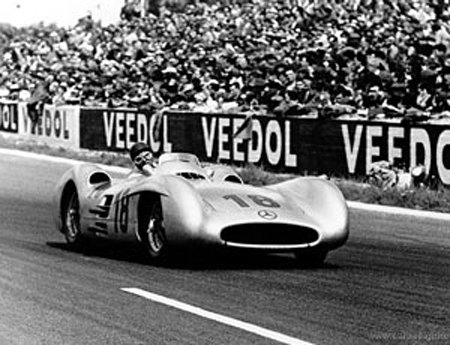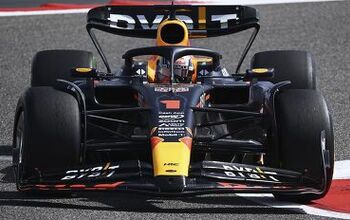The Mother of All F1 Cars
Upon first inspection, GP cars seem to be the automotive embodiment of modern thinking. Extreme aerodynamic development, lightweight materials of almost unimaginable strength, mind-boggling precision in both design and manufacture — they’re an astounding technological showcase on every level. But like all highly evolved organisms, the four-wheeled missile you see today is merely the way-point on a journey from the past to the future. In the most fundamental way, today’s F1 cars’ trace their lineage back to the very first GP cars.
Though crude compared to today’s machines, the first GP cars were not what you’d call underpowered. Consider the power-to-weight ration of the 1954 Maserati 250F. The Maser weighed in at around 630 kg (1389 lbs.). It holstered a 2.5-liter in-line six cylinder engine with three carburetors and an alloy block. The powerplant produced roughly 240 horsepower @ 6500 rpm. Conceptually, the 250F was kin to the cars that had been raced since the turn of the century: front engine, rear-wheel drive with narrow tires and a basic (leaf) suspension. The cars’ dynamics necessitated a drastically different driving technique than that used by today F1 pilots. In this era, drifting was king.
Because of the high polar moment of inertia inherent in a car with a significant portion of its weight located near its ends, maintaining momentum was the key to speed, rather than stopping and accelerating. To that end drivers used power-induced oversteer to swiftly navigate the sweeping turns of the race courses of the day, such as Monza and AVUS. Though the Maser was extremely successful, carrying many drivers to wins across several years, it was to be the last, best GP car of its type.
As racing bloomed across post-war Europe, the sport was ripe for mechanical innovation. Mercedes showed the way forward. In 1954, the German automaker introduced the W196, which incorporated several innovations taken directly from the aircraft industry. The car had a slippery, wind-tunnel tested all-inclusive shell; an aerodynamic design unlike anything GP had ever seen. To keep the frontal area low, the car’s straight eight engine was tilted on its side– a set-up made possible by the introduction of fuel injection (also borrowed from airplane technology). And if that wasn’t enough to bury the competition (it was), the W196 also ditched racing’s traditional ladder frame chassis for a stronger yet lighter space frame.
But it was the British Cooper team who created the sport’s greatest leap forward. The team had its roots in the insignificant 500cc Formula Three junior series. To facilitate relatively cheap racing, F3 cars were powered by motorcycle engines. Because motorcycle engines deliver their power via chain drive, it’s natural to position the engine as close to the driven axle as possible (in this case, the rear). By positioning the powerplant ahead of the rear axle (but behind the driver), the resulting car had an optimum weight distribution for changing direction: 50 – 50. And there you have it: the mid/rear-engine layout.
When Cooper began to understand the inherent advantages provided by the mid-engine layout, it was only a matter of time until bigger engines and more money thrust John Cooper and his revolutionary design into the limelight. That said, the idea wasn’t initially popular. Enzo Ferrari famously derided the mid-engined layout, saying that the “horse should pull the cart, not the other way around.” Cooper scored their first victory in the 1958 Argentinean Grand Prix with a T43 driven by Stirling Moss. With this surprise success– a privateer team besting the [admittedly small] field of six snarling, front-engine Ferraris and three Maseratis with a relatively inexpensive mid-engined race car– the way forward had become clear.
The Cooper T43 and T51 produced similar power levels to the front-engine beasts of the previous generation: about 240 hp. But the Coopers weighed almost 170 kilos less, and their drastically superior dynamics provided a quantum leap in performance. In fact, the Cooper cars provided the basic foundation of the modern F1 car: mid-engine layout and light-weight design with fully independent front and rear suspension; complete with hydraulic disc brakes.
The Coopers were the blue print for the next generation and their DNA permeates modern GP cars. Excluding the space frame chassis, which was soon to be replaced with monocoque construction, these cars are fundamentally the same as the ultra-modern cars that fill today’s F1 grid. The Cooper can be called the first F1 car of the modern sort – all of the designs that have followed have been extensions of the lowly Cooper F3.
More by Mitchell Yelverton
Latest Car Reviews
Read moreLatest Product Reviews
Read moreRecent Comments
- Danddd Or just get a CX5 or 50 instead.
- Groza George My next car will be a PHEV truck if I can find one I like. I travel a lot for work and the only way I would get a full EV is if hotels and corporate housing all have charging stations.I would really like a Toyota Tacoma or Nissan Frontier PHEV
- Slavuta Motor Trend"Although the interior appears more upscale, sit in it a while and you notice the grainy plastics and conventional design. The doors sound tinny, the small strip of buttons in the center stack flexes, and the rear seats are on the firm side (but we dig the ability to recline). Most frustrating were the repeated Apple CarPlay glitches that seemed to slow down the apps running through it."
- Brandon I would vote for my 23 Escape ST-Line with the 2.0L turbo and a normal 8 speed transmission instead of CVT. 250 HP, I average 28 MPG and get much higher on trips and get a nice 13" sync4 touchscreen. It leaves these 2 in my dust literally
- JLGOLDEN When this and Hornet were revealed, I expected BOTH to quickly become best-sellers for their brands. They look great, and seem like interesting and fun alternatives in a crowded market. Alas, ambitious pricing is a bridge too far...




































Comments
Join the conversation
Spelling correction to last post: Belgium.